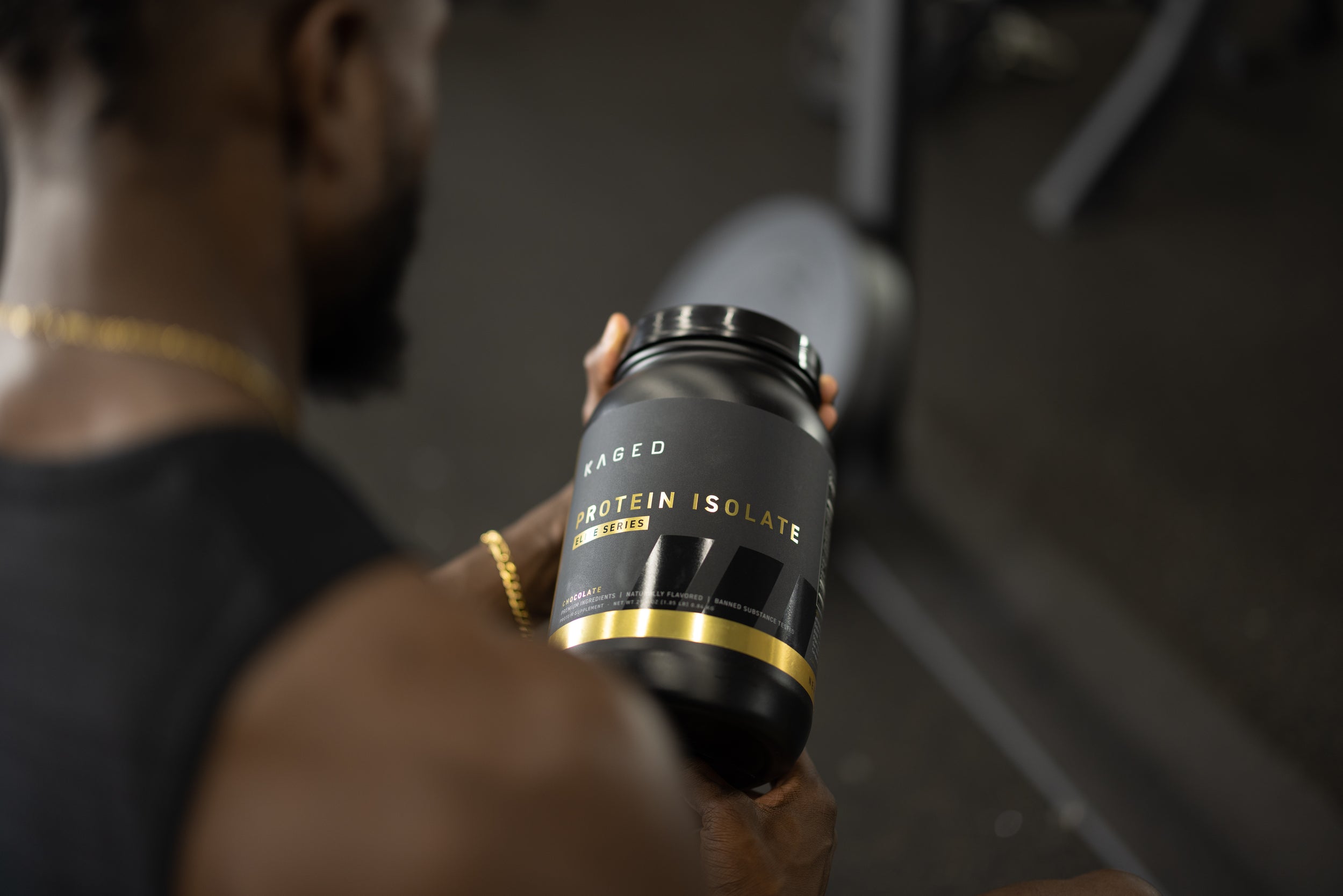For building muscle and supporting recovery, there are two classic forms of protein powder: whey and casein.
In today's article, we'll look at the similarities and differences that matter.
Whey protein is a fast-digesting protein derived from milk, making it ideal when you need a quick hit of amino acids.
Casein protein, also from milk, is a slow-digesting protein that provides a steady release of amino acids, perfect for muscle maintenance over longer periods, such as overnight.
Whey vs Casein Protein at a Glance
| Feature |
Whey Protein |
Casein Protein |
| Digestion Speed |
Fast — digests within 1–2 hours |
Slow — releases amino acids for 6–8 hours |
| Best Time to Take |
Post-workout or during the day |
Before bed or between meals |
| Leucine Content (Muscle Growth) |
Higher, triggers rapid muscle protein synthesis |
Moderate, supports long-term muscle repair |
| Texture & Mixability |
Light, smooth, mixes easily |
Thick, creamy, can clump when shaken |
| Satiety (Fullness) |
Short-term fullness |
Long-term sustained fullness |
| Lactose Content |
Low (especially isolate) |
Moderate (higher than whey isolate) |
| Ideal Uses |
Post-workout shakes, quick recovery |
Overnight recovery, recipes, or long gaps between meals |
| Found In Kaged Products |
Whey Protein Isolate, Protein Isolate Elite |
Micellar Casein, Protein Isolate Elite |
Where Whey vs Casein Protein Comes From
Both whey and casein proteins originate from milk, but they’re separated during the cheese-making process. Whey is the liquid portion that gets strained off, while casein makes up the curds, or the solid part. This separation gives whey its fast-digesting properties and casein its slow, sustained release, offering unique benefits depending on your fitness and nutrition goals.

Whey & Casein: The Key Differences
There are many differences, but in our experience, there are only two that matter: digestion rate and how well it mixes.
1) Digestion Rate: Fast vs Slow
The main difference you’ll hear about is the digestion rate.
Whey protein is known for its rapid digestion, which, so the typical story goes, makes it ideal for post-workout recovery when your muscles are in need of a quick influx of amino acids to kickstart the repair process.
(However, the research on the post-workout window is mixed at best, and has put the importance of getting fast-digesting protein into question.)
Casein protein digests much slower. It forms a gel-like substance in the stomach, allowing for a gradual release of amino acids into the bloodstream over several hours. This slow digestion makes casein an excellent choice when you need a sustained protein source, such as before bed or in between meals, to help prevent muscle breakdown during long periods without food.
As we wrote about in this article on casein for recovery, there's strong research that suggests taking casein in the evening supports recovery and muscle building.
2) Mixability: Smooth vs Thick
While the digestion rate is what’s most talked about, the real reason why people choose whey over casein is that it mixes and tastes better.
Whey mixes smoothly in just water or milk, creating a light, easy-to-drink shake that’s perfect for quick consumption on the go.
This convenience is one of the reasons why whey remains the go-to protein powder for so many people, especially post-workout when you want something quick and palatable.
Casein, on the other hand, is much thicker and doesn’t mix as easily. It often forms clumps and has a creamier, heavier texture that some find challenging to “get down” when used in a simple shake. Yes, choosing higher-quality casein, like micellar casein, improves this, but it won’t reach the levels of whey on its own.

Casein is Better for Recipes
Because of its thickness, casein is often better suited for recipes, like this coconut casein pudding recipe, overnight oats, baked goods, or these chocolate peanut butter protein balls.
Or it can be combined with whey to balance the mixability and give a creamy texture, as we do in Kaged Protein Isolate Elite.
This blend approach can offer the best of both, providing the fast-digesting benefits of whey with the sustained release of casein, without the hassle of thick, clumpy shakes. Learn more about Kaged Protein Isolate Elite here.
In the grand scheme, these are the only two differences that make a substantial difference for most people.
3) Amino Acid Profiles: BCAAs vs Glutamine
Whey and casein proteins, both derived from milk, have similar but distinct amino acid profiles.
Essential Amino Acids
Both whey and casein are complete proteins, containing all nine essential amino acids. However, there are some key differences:
Leucine Content: Whey protein has a higher leucine content compared to casein. Leucine is particularly important for stimulating muscle protein synthesis. This is another reason why it’s a favorite as a workout protein. Whey also has higher levels of isoleucine, another branched-chain amino acid.
Glutamine: Casein has a higher amount of glutamine compared to whey. Glutamine supports immune function and may aid in muscle recovery. It even supports healthy gut function.*
Amino Acid Profile Comparison
Here's a more detailed breakdown of the amino acid profiles:
| Amino Acid |
Whey |
Casein |
| Leucine |
Higher |
Lower |
| Isoleucine |
Higher |
Lower |
| Valine |
Similar |
Similar |
| Lysine |
Similar |
Similar |
| Threonine |
Similar |
Similar |
| Methionine |
Similar |
Similar |
| Phenylalanine |
Similar |
Similar |
| Histidine |
Similar |
Similar |
| Tryptophan |
Similar |
Similar |
| Glutamine |
Lower |
Higher |
4) Lactose Content
Generally, casein protein contains more lactose than whey protein isolate, which undergoes additional processing to remove most of the lactose. This includes micellar casein, the more filtered form of casein protein. As a result, whey protein isolate is significantly lower in lactose, making it a more tolerable option for those sensitive to dairy.
For people with lactose intolerance, whey protein isolate is often the better choice. A typical serving of Kaged Whey Protein Isolate contains less than 0.1 grams of lactose, a trace amount that many individuals with lactose intolerance can consume without experiencing discomfort.
However, depending on the severity of your lactose intolerance, you'll want to avoid dairy-based protein powders altogether.
5) Satiety: Short-term vs. Long-term
Whey Protein: Whey protein is known to be more satiating in the short term. After consumption, it quickly spikes amino acid levels in the blood, which helps reduce food intake during meals consumed 30-90 minutes later. This rapid digestion triggers a quick release of satiety-inducing hormones like GLP-1, making whey protein an excellent option for curbing hunger right after a meal or workout.
Casein Protein: In contrast, casein protein provides more sustained satiety over longer periods. Due to its slow digestion and gel-forming properties in the stomach, casein releases amino acids gradually, making it more effective for meals eaten about three hours after ingestion. This prolonged release helps maintain fullness and can reduce daily energy intake over time.
Choose Ultra-Filtered Forms: Whey Protein Isolate and Micellar Casein
Whether you choose whey, casein, or both, it's important to choose a high-quality option.
Look for "whey protein isolate," instead of concentrate, and micellar casein over other forms of casein.
These terms refer to how well the protein has been filtered, not the type of protein itself.
If you’re curious about the differences between concentrate and isolate, check out our detailed breakdown here.
We discuss this more in this article on why micellar casein is the only form of casein protein you should use.
Get the Best of Both With Kaged Protein Isolate Elite
Rather than viewing whey and casein as competing options, they can be seen as complementary proteins that work well together. Their different digestion rates—whey's fast and casein's slow—can be strategically combined to provide varying satiety effects that meet diverse nutritional needs. This blend of "fast" and "slow" proteins is precisely what you get with Kaged Protein Isolate Elite, which includes both whey and casein in a precise 2:1:1 ratio for whey isolate, milk isolate, and micellar casein. This combination offers the best of both worlds, helping to manage hunger immediately after consumption and providing sustained fullness throughout the day.
The Myth of The Post-Workout Window?
Research on the benefits of the famed “post-workout window” has called it into question over the past few years.
Given this, the logic that you need fast-digesting protein right after training likely isn’t as important as has been emphasized over and over again by the health and fitness industry.
That’s another reason why a blend, which provides a steady release of amino acids over several hours, is a great choice for your protein powder.
Whey + Casein: The Ideal Texture
When combined, whey and casein create a texture that balances the best qualities of both proteins. Whey’s light, smooth consistency mixes easily, making it perfect for quick shakes. On the other hand, casein’s thicker, creamier texture can enhance the mouthfeel, giving your shake a richer and more satisfying experience.
In products like Kaged Protein Isolate Elite, this blend results in a perfectly balanced shake that’s neither too thick nor too thin. The addition of casein provides a creamier texture without the heavy, clumpy feel it often has on its own, making it a delicious and versatile option for those looking to elevate their protein intake.

SHOP PROTEIN ISOLATE ELITE
Kaged Casein is Back!
If you're looking for nighttime recovery, Kaged Casein delivers high-quality, 100% micellar casein protein.
Kaged Casein will also be our best option for those looking to use protein in recipes, due to its thicker texture.
We're thrilled that Casein is available once again, and we've brought it back in both chocolate peanut butter and vanilla cake flavors.

SHOP CASEIN
FAQs: Whey vs Casein Protein
1. Is whey or casein better for building muscle?
Both support muscle growth, but in different ways. Whey protein digests faster and contains more leucine, which rapidly stimulates muscle protein synthesis. Casein digests slower, sustaining amino acid release and supporting overnight recovery.
2. When should I take whey vs casein protein?
Take whey protein right after workouts or during the day for quick recovery. Use casein before bed or during long breaks between meals to maintain a steady flow of amino acids.
3. Can I take whey and casein together?
Yes — combining them offers the best of both worlds: fast recovery and sustained support. Kaged Protein Isolate Elite blends whey and casein in a 2:1:1 ratio for balanced digestion and optimal performance.
4. Is casein protein better before bed?
Yes. Casein’s slow digestion rate provides a steady amino acid release while you sleep, helping reduce muscle breakdown overnight.
5. Which protein is better for lactose-sensitive people?
Whey protein isolate is typically best because most lactose is filtered out. Micellar casein still contains moderate lactose levels, so those with lactose intolerance should choose an isolate or plant-based option.
6. What’s the difference between micellar casein and casein hydrolysate?
Micellar casein is the pure, natural form that digests slowly, while casein hydrolysate is pre-digested for faster absorption. Micellar casein is considered the gold standard for overnight recovery and satiety.
*These statements have not been evaluated by the FDA. This product is not intended to diagnose, treat, cure, or prevent any disease.



































